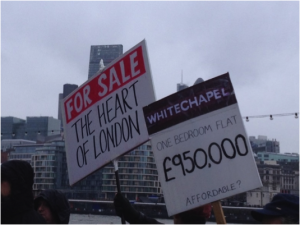 From our own CorRUPSpondent – A series of blog posts written by students and alumni of the MSc Regional and Urban Planning Studies programme at the LSE.
From our own CorRUPSpondent – A series of blog posts written by students and alumni of the MSc Regional and Urban Planning Studies programme at the LSE.
Author: Clementine Traynard
On Saturday 31 January, I joined in thousands of Londoners for the first ever March for Homes. Our objective? “Better homes for Londoners and an end to the housing crisis” according to the Facebook event page. What a laudable, consensual cause. But is it a lost cause, as many of my friends’ cynical remarks would lead me to believe?
How will the fact that a few thousand idealists braved the rain and freezing temperatures crossing East and South London to rally in front of Boris’ offices change anything to the housing situation in London?
I’ve studied the housing sector – in fact I just wrote my master’s dissertation at LSE on the London housing crisis – and nowhere in the academic debates did I find that standing in the rain catching the flu would be part of the solution. But I have to say, the March for Homes brought a lot to its participants, and hopefully to the wider public.
Like most social movements, the March for Homes was about asserting that an alternative is possible. It is about people refusing to buy the “inevitability” argument. It is about reminding politicians that they have been elected to take action and prevent the invisible hand of the market from controlling people’s lives.
It is about people refusing to buy the “inevitability” argument. It is about reminding politicians that they have been elected to take action and prevent the invisible hand of the market from controlling people’s lives.
As a recent Urban Planning graduate, I marvelled at every little symbolic detail along the March. Leaving behind the gentrification capital of Shoreditch, the route passed along the construction site of Aldgate Place, where Barratt Homes is already selling one bedroom flats for a minimum of £700,000. This also happens to be the borough of Tower Hamlets, where one child in two lives in poverty. Crossing Tower Bridge, we arrived in City Hall, the heart of local democratic representation in London, which is surprisingly enough a ‘privately owned public space’ controlled by private security who kindly granted us permission to voice our anger at this whole absurdity.
The situation seems depressing, but taking part in the March did give me some hope for change. I have been to several other public protests about housing issues including the occupation of the Carpenters Estate in Newham by the Focus E15 group and the demo against revenge evictions in front of Parliament in November and what was different this time was a real sense of unity among different interests. The March brought together council tenants, private renters, unionists, anarchists, feminists, socialists, communists, Green Party activists, and many non-affiliated individuals who for some reason felt the need to come together and make a point of expressing their refusal of the situation.
The message was unity: the housing crisis is not only affecting social tenants or people on housing benefits. The housing crisis is bad for all of us. Everyone who wants to live in London today and who did not buy a house before 1980 is affected and is spending more than what one should on housing.
The message also had a desperate dimension when considering the potential consequences of non-action: irremediable social cleansing of London, with the city losing its praised diversity but also probably triggering systematic flaws as key workers – well represented at the March – can no longer afford to live in London. As one placard stated, what is at stake is the very heart of London.
But fortunately, the message was also about bringing solutions. A large colourful banner stated “This is the beginning of the end of the housing crisis”. The main demands included a revision of the current definition of affordability as 80% of the market price, the end of council estates demolitions, and control over properties being used as investment rather than housing. A great deal of placards also targeted the overheated Private Rented Sector.
These demands were reasserted on Wednesday at Generation Rent’s “Rent Freedom Day” lobby event, bringing local housing grassroots movement to the next level of political a ction. Political parties were directly confronted and asked to take position on housing policies such as rent control. In France a normal tenancy is three years and tenant evictions are suspended for six months during the winter period. Why could it not be the case in England? Newham Council started a landlord registry that has proved to bring positive changes to the sector, starting a precedent that could be followed by others. The level of deregulation achieved in the housing sector in the UK is tremendous, and the trend has to be reversed before capitalism’s inherent contradictions make the whole system crash. In order to function as a coherent global city, London needs to ensure long-term affordability in housing and this can only be achieved with strong political commitment from both local and national governments.
ction. Political parties were directly confronted and asked to take position on housing policies such as rent control. In France a normal tenancy is three years and tenant evictions are suspended for six months during the winter period. Why could it not be the case in England? Newham Council started a landlord registry that has proved to bring positive changes to the sector, starting a precedent that could be followed by others. The level of deregulation achieved in the housing sector in the UK is tremendous, and the trend has to be reversed before capitalism’s inherent contradictions make the whole system crash. In order to function as a coherent global city, London needs to ensure long-term affordability in housing and this can only be achieved with strong political commitment from both local and national governments.
I believe that this week’s events were necessary to push for strong legislative change in housing policy and to make it a top priority in the coming general elections. The recent upsurge of the Green Party and the fact that it is the most committed party behind the housing movement is not, in my opinion, a pure coincidence. The other big parties will now have to follow.





